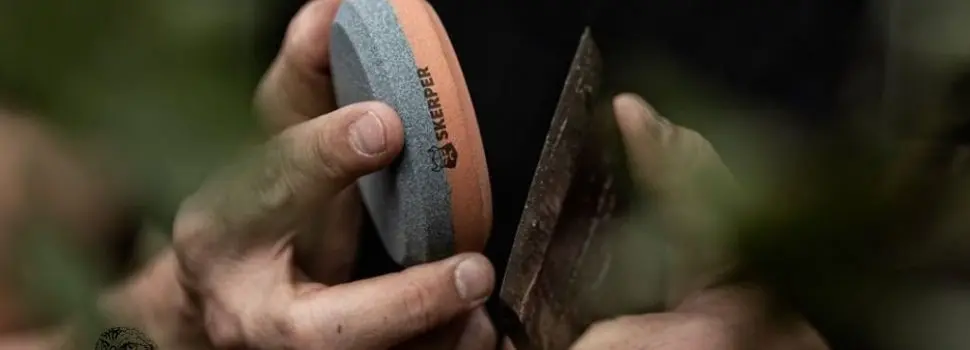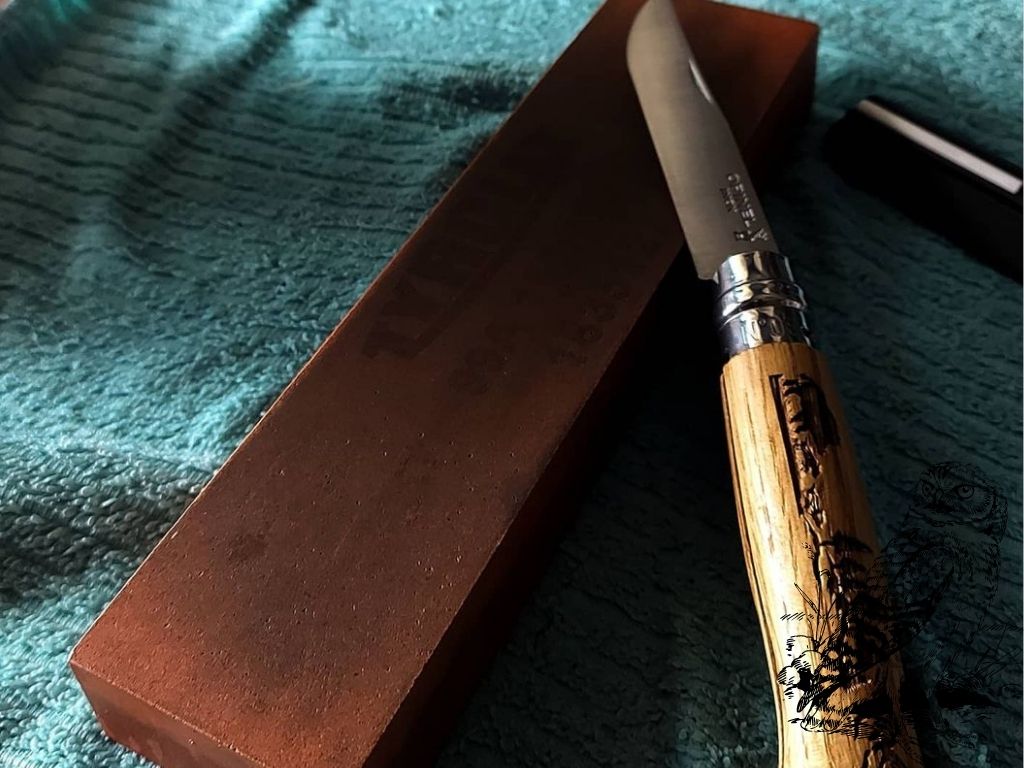


Wood carving is a hobby that requires razor-sharp blades at all times. Whether you are a professional or a beginner, the cutting edge of your blade needs to be sharpened regularly and properly. Dull blades can be very dangerous and cause a series of injuries due to the pressure you need in order to achieve the desired curves.
If you don’t know how to sharpen carving tools yet, this post is for you. Sharpening carving tools is an important part of wood carving and knowing how to strop a blade accordingly is first and foremost a matter of safety in your work.
Types of Sharpening Tools
Tools for sharpening knives can be made of different materials and come in many shapes, to adjust to any curved blade. In general, there are three main types of sharpening tools: a sharpening stone, sandpaper, and leather strops.
Sharpening Stones

Sharpening stones for wood carving tools are used for sharpening dull tools, and they are natural or synthetic. They are made of either novaculite, aluminum oxide, or silicon carbide. There are three ways to sharpen your blade with a sharpening stone:
- Pulling the stone towards you along the blade edge;
- Pushing the stone away from you (the most common type);
- Make circular movements with the stone over the blade edge.
Sandpapers

Sandpaper is often used for sharpening curved blades because of its flexible yet firm structure. There are different grit sandpapers, and these vary from whether you need strong sanding to even-up the blade edge that could be damaged or polish the cutting edge to be sharper.
Leather strops

Leather strops are typically used for honing and polishing, and they are the gentlest out of the three tool types. A leather strop can be just a piece of leather, fixed onto a woodblock, or a paddle for easier use. There are different compounds that you can spread on the strop, depending on the grit you need. The most common one is the green honing compound.
Apart from these three main tool types, electric tools operate under the principle of rotating sandpaper or a strop for you, while you press the cutting edge against it. This wood carving tool sharpening system is not as common, and it is more used by woodworkers for larger blades than for carving tool sharpening.
Types of Blades on Different Tools

Wood carving tools have either a straight blade, like a whittling knife, or a curved blade, like a gouge or a hook knife. Another important thing to pay attention to is whether you are sharpening a single-edged or a double-edged blade (a blade with two cutting edges).
How to sharpen straight blade knife?
Straight blades such as a carving knife and whittling knife are easy to sharpen, and with either sharpening tool, the principle is the same: gently brushing the blade edge over the sharpening or honing material.
How to sharpen Scrall Saw?
Some craftsmen find it challenging when learning how to sharpen a hand saw, because of its specific edge. Hand saw sharpening is very easy and it is based on the same principle as sharpening any other blade, it only involves a few extra steps. First of all, you need to hold the saw firmly with a bar clamp, with the teeth facing up. Use a large sharpening stone to even the tips of all teeth, and after that use a small sharpening stick to sharpen each tooth one by one.
It is easy to learn how to sharpen wood carving tools with a stone, but even easier to do it with sandpaper or leather strop. When it comes to knowing how to sharpen special carving tools, such as a hook knife, it is all about finding the right shape of the sharpening tool to slide it over the blade’s edge.
How to sharpen gouges?
When we talk about how to sharpen a gouge (sharpening carving chisels, or any slightly bent or curved blade), my preference is using sandpaper glued onto a cylinder (strick). With a cylinder shape, it is very easy to follow the curve of the blade and gently strop the blade towards the curing edge.
Sharpening wood carving tools is a smooth process, and it doesn’t require any strength. Adding pressure onto the tool while sharpening it can result in damaging the blade, so be as gentle as possible and repeat the movement until the edge is razor-sharp.
Sharpening process Tips
Sharpening stone and sandpaper are usually used for rough sharpening when you need to fix any lumps on the blade edge. For achieving the razor-sharp effect upon sharpening, the final tool you should use is the leather strop.
I prefer using a leather paddle strop since it enables me to have more control over the whole process. The first thing to know about how to sharpen wood carving tools with a strop is choosing the right compound. These compounds vary in grit size, and they go from rough to very fine ones. Most craftsmen use the green honing compound, but it is also good to try out the black and the very fine white one, for long-lasting fine sharp tools.
A sharpening stone is an excellent choice for tools that you use with excessive pressure, such as when you carve hardwood. Sandpaper is usually more than enough for most wood carving blades, and it is handy to have in your workshop at all times. A leather strop is a necessary tool in every woodcarver’s toolkit, and having different compound types is highly recommended.
FAQs
What the bevel of the sharpening should be?
Before using a carving tool sharpener, it is good to determine which bevel of the cutting edge you need. Each craftsman has their own preferences, but the general tip is to keep a shallow angle (15° to 20°) for softwood that is easy to carve, such as basswood, and a steep angle (25° to 35°) for hardwood such as oak. Bear in mind that the bevel is sharpened with a sharpening stone or sandpaper with rougher grit than the one you use for the entire blade.
What is the best way to sharpen wood carving tools?
The blades of wood carving tools come in many shapes and they have one or two cutting edges, which is why sharpening these blades is not quite the same. The style of how to sharpen a wood carving knife is not just the same as sharpening a gouge, for example. The general advice is to stroke the blade over the sharpening tool surface (stone, strop) many times in the direction towards the cutting edge.
Carving tool sharpening is a gentle process, so do not use force. The best way to sharpen wood chisels, hook knives, as well as sharpening gouges, or any other curved blades is to use the sharpening tool that matches the shape of the curve, and stroke the blade gently as with any other carving knife. Check out our tutorial on how to sharpen wood carving tools pictures guide for a detailed view of how the knife sharpening looks like.
What do you sharpen wood carving tools with?
You can sharpen carving tools at home, and the equipment you need is easy to purchase in any wood carving or woodworking store. If you are attached to a certain brand of tools, you can purchase their sharpening tools like Flexcut knife strop or a Morakniv set. Three different tools are used to sharpen the blades: a quality stone, sandpaper, and a leather strop. It is easy to learn how to use a leather strop to sharpen carving tools, although the leather is usually used for honing and the final touch at the very end. Sandpaper and stone are more effective when it comes to sharpening dull tools, and the tools you haven’t been using in a long time.



No comments so far.
Be first to leave comment below.